DNA
A rapid non-destructive DNA extraction method for insects and other arthropods
| Publication Type | Journal Article | |
| Year of Publication | 2010 | |
| Authors | Castalanelli, M.A.; Severtson, D.L.; Brumley, C.J.; Szito, A. | |
| Journal Title | Journal of Asia-Pacific Entomology | |
| Volume | 13 | |
| Issue | 3 | |
| Pages | 243-248 |
Plant nematology as a discipline is in a state of depletion in Australia at present, yet nematode pathogens cause losses of at least $450 million per annum in Australia and US$120 billion each year in crop losses worldwide.
There are some serious emergency nematode pathogens, such as the potato cyst-nematodes (Globodera rostochiensis, G. pallida), and stem nematodes (Ditylenchus dipsaci), and their presence is a quarantine issue and a non-tariff barrier to trade. In the past three years several additional species of root-lesion nematode (Pratylenchus spp) have been found in Western Australia (WA). The cereal cyst nematode (Heterodera avenae) is now known to be much more widely spread in WA than previously thought. The root-knot nematode Meloidogyne fallax has recently been detected in WA, and related species such as M. artiellia are serious problems in chickpeas grown in the Mediterranean region where new germplasm is often collected for Australian crop improvement. Climate modelling also indicates that many nematode pests of Mediterranean, sub-tropical and tropical regions would survive well if introduced into Australia.
What is the biosecurity problem?
In order to improve Australian biosecurity against new incursions of nematode pathogens, it is essential to conduct a risk analysis, to assess potential agricultural and horticultural zones at risk.
There is also a need to have improved technologies available to detect, identify and eliminate exotic plant parasitic nematodes. This will enable potential new incursions to be predicted, controlled, and a thorough knowledge of nematode issues will also promote Australian trade and market access through high quality evidence-based support of phytosanitary issues and regulations.
The main outputs of this project were to:
- train an individual to the PhD level in plant parasitic nematode biology, risk assessment and taxonomy
- train an individual to the PhD level in classical and molecular diagnostics of plant nematode pathogens
- develop and validate new high throughput nematode diagnostic techniques for surveying and monitoring the presence of nematode pathogens
- provide a trained individual with expertise and understanding of plant biosecurity issues, who can take on a leadership role in this area of biosecurity of soil-borne pathogens, and
- develop a faster detection techniques such as MALDI-TOF MS
Who are the end-users of this research?
Personnel without nematode knowledge, Australian Quarantine Inspection Services officers and the agricultural industry in general.
The Estonian translation of this page is available here.
STUDENT
PROJECT DETAILS
Complete
Supervisor
Professor Michael Jones (Murdoch University) and Dr Vivien Vanstone (Department of Agriculture and Food, Western Australia)
Supervising Institution
Murdoch University
Term
August 2009 - June 2010
LOCATION
DNA Testing for Phosphine Resistance - The Future of Resistance Monitoring and Management
| Publication Type | Conference Proceedings | |
| Year of Publication | 2008 | |
| Authors | Schlipalius, D.; Jagadeesan, R.; Mau, Y.; Collins, P.; Ebert, P. | |
| Conference Name | International Conference on Controlled Atmosphere and Fumigation in Stored Products | |
| Conference Start Date | 21/09/2008 | |
| Conference Location | Chengdu |
The uses of plant disease and insect collections are numerous but most importantly for taxonomic research and comparative biology. From a biosecurity perspective, these collections allow the development of specimen-based pest lists that are critical for resolving quarantine issues related to agricultural trade. Typically, plant disease and insect specimens are stored in a way that helps preserve the organisms' morphology but not necessarily their DNA. In the age of genomics, DNA sequencing has become one of the most important tools for identifying organisms and for biodiversity studies.
Research outcomes:
The major outcome of this project was the development of the Biosecurity Bank, a national reference collection of DNA samples from plant pathogens. In building the framework for the Biosecurity Bank, the existing Queensland Primary Industries and Fisheries Plant Disease Herbarium database was modified to include new fields for the archiving of information relating to DNA samples and clones. Using this database, it is now possible to link DNA samples to voucher specimens to facilitate taxonomic verification at a later date.
A new web site, www.biosecuritybank.com, was also developed to provide a portal to the DNA collection for the general scientific community to allow searches for samples of interest. The domain has been registered and the site is now live and hosted by Southern Cross University.
A method for storing DNA at room temperature was evaluated but unfortunately, this method did not preserve the DNA as well as storage in a freezer and therefore the latter has been adopted for maintenance of the collection.
Work has begun to populate the Biosecurity Bank with samples and so far 36 samples have been added including those from pathogens that cause citrus canker, tomato leaf curl and Panama disease.
Research implications:
Plant disease herbariums are reference collections of microorganisms (plant pathogens) that cause disease on crops, weeds and native plant species. Specimens held in these collections are important for taxonomic and biodiversity research but also are very important for biosecurity as they allow the development of specimen-based pest lists that are needed for resolving quarantine issues associated with agricultural trade.
Pressed plant specimens are the most common type of specimen held in plant disease herbariums, and provide a good record of the pathogen’s morphology. However, as previously stated this method of storage is sub-optimal for preserving DNA.
In developing the Biosecurity Bank, the Australian scientific community is now provided with a reference collection of DNA samples from plant pathogens, which could potentially be used in all types of research projects, from the development of molecular diagnostic assays to ‘gene-mining’ for biologically-active compounds. To provide even greater assurance of the origin of the DNA, samples will be linked to voucher specimens held in Australian plant disease herbariums.
Acknowledgements:
Funding from the Office the Chief Plant Protection Officer, Australian Department of Agriculture, Fisheries and Forestry, is gratefully acknowledged.
PROJECT LEADER
Dr Andrew Geering
Project Leader CRC20055: DNA Databank
andrew.geering@deedi.qld.gov.au
Phone: 07 3896 9353
Fax: 07 3896 9533
Read More
PROJECT DETAILS
Complete
Term
July 2007 - April 2008
Budget
$129,000 (cash and in-kind resources)
PROGRAM DETAILS
LOCATION
CORE CRC PARTICIPANTS
SUPPORTING CRC PARTICIPANTS
This project will develop tools for plant pathogen recognition to support rapid response to disease threats.
What is the biosecurity problem?
The development of tools for pathogen recognition enabling rapid response has been listed as one of the top issues to improve Australia's preparedness to deal with emerging disease threats.
The main outputs of this project are to:
- develop methodology for DNA detection of airborne pathogens from spore traps using known model systems.
- develop methodology for monitoring exotic and unknown pathogens in spore traps (using community analysis DNA methods such as T-RFLP).
- develop and evaluate alternative eradication strategies for high priority emergency plant pests affecting industries based on perennial species.
Who will be the end-users of this research?
This project will deliver a new PhD graduate trained in plant pathology with specific skills in pathogen detection and monitoring. The graduate will be available for employment within the Australian plant biosecurity system, enhancing Australia's capacity for pathogen recognition and enabling rapid responses to emergency plant pests.
STUDENT

Ms Bonny Vogelzang
Student CRC60017: Detection in Pathogen Mixtures - PhD
vogelzang.bonny@sa.gov.au
Phone: 08 8303 9390
Fax: 08 8303 9393
Read More
PROJECT DETAILS
Complete
Supervisor
Dr Jenny Davidson , SARDI
Supervising Institution
University of Adelaide
Term
July 2006 - June 2009
LOCATION
This project developed an accurate, reliable and internationally recognised DNA-based protocol to detect Karnal bunt. The methodology was validated by laboratories in Australia and overseas and the resulting Diagnostic Protocol was endorsed by the Subcommittee on Plant Health Diagnostic Standards and the Plant Health Committee. This practical biosecurity tool will support the Plant Health Australia National Karnal Bunt Contingency Plan.
Research outcomes
- The development of a one tube, fluorescent polymerase chain reaction (PCR) assay for the simultaneous detection and unequivocal identification of T. indica and closely related Tilletia spp. when only a few spores have been observed. The key features of the assay are:
- elimination of spore germination step
- direct molecular analysis of a single spore, and
- simultaneous detection of T. indica and related grass bunts resulting in reduced labour and reagent costs.
- The development of an enhanced protocol for the quarantine detection of T. indica and other grass bunts in wheat grains. The combination of a microscopy step and direct molecular analysis of single spores in the confirmation stage will give a near zero risk of a false positive in the diagnostic process.
- An economic comparison of current and enhanced protocol for quarantine detection and surveillance of T. indica, the cause of Karnal bunt in wheat.
Research implications
- The enhanced protocol should be integrated as a beta version in a diagnostic section of a centralised national or state facility for animal and plant biosecurity. This will enable the refinement of the protocol for high throughput diagnosis and the development of a capacity for an emergency response to Karnal bunt.
- The enhanced protocol bypasses the germination step in identification and so the number of days elapsing before definitive confirmation is considerably lower than in the current protocol. This is critical in an incursion when huge quantities of wheat grain are being held at ports for export pending an outcome of diagnosis. Use of the enhanced protocol will result in massive savings to the industry.
- The savings in cost and time in the enhanced protocol relative to the current protocol make it an economically sustainable tool to be used in a grass bunts surveillance program to ensure continuous freedom of the disease and increase market access.
Acknowledgements
- Grains Research and Development Corporation
- NSW Department of Primary Industries
- Cooperative Research Centre for National Plant Biosecurity
- Department of Agriculture and Food Western Australia
PROJECT LEADER

Dr Mui-Keng Tan
Project Leader CRC20004: Karnal Bunt Detection
mui-keng.tan@industry.nsw.gov.au
Phone: 02 4640 6445
Fax: 02 4640 6300
Read More
PROJECT DETAILS
Complete
Term
March 2006 – June 2009
Budget
$535,175 (cash and in-kind support)







